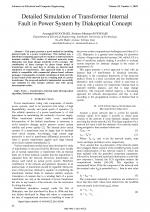| 3/2010 - 8 |
Detailed Simulation of Transformer Internal Fault in Power System by Diakoptical ConceptKOOCHAKI, A. |
| Extra paper information in |
| Click to see author's profile in |
| Download PDF |
Author keywords
transformers, internal fault, decomposition algorithm, distributed simulation
References keywords
power(13), systems(7), transformers(6), transformer(5), faults(5), studies(4), piecewise(4), kouhsari(4), internal(4), applications(4)
Blue keywords are present in both the references section and the paper title.
About this article
Date of Publication: 2010-08-31
Volume 10, Issue 3, Year 2010, On page(s): 48 - 54
ISSN: 1582-7445, e-ISSN: 1844-7600
Digital Object Identifier: 10.4316/AECE.2010.03008
Web of Science Accession Number: 000281805600008
SCOPUS ID: 77956621326
Abstract
This paper presents a novel method for modeling internal faults in a power transformer. This method uses a distributed computing approach for analysis of internal fault in transient stability (T/S) studies of electrical networks using Diakoptics and large change sensitivity (LCS) concepts. The combination of these concepts by phase frame model of transformer will be used here to develop an internal fault simulation of transformers. This approach leads to a model which is compatible with commercial phasor-based software packages. Consequently, it enables calculation of fault currents in any branch of the network due to a winding fault of a power transformer. The proposed method is implemented successfully and validated by time domain software and GEC group measurement results. |
| References | | | Cited By |
Web of Science® Times Cited: 3 [View]
View record in Web of Science® [View]
View Related Records® [View]
Updated today
SCOPUS® Times Cited: 4
View record in SCOPUS® [Free preview]
View citations in SCOPUS® [Free preview]
[1] Verification of Transformer Restricted Earth Fault Protection by using the Monte Carlo Method, KRSTIVOJEVIC, J. P., DJURIC, M. B., Advances in Electrical and Computer Engineering, ISSN 1582-7445, Issue 3, Volume 15, 2015.
Digital Object Identifier: 10.4316/AECE.2015.03009 [CrossRef] [Full text]
[2] A New Method of Improving Transformer Restricted Earth Fault Protection, KRSTIVOJEVIC, J. P., DJURIC, M. B., Advances in Electrical and Computer Engineering, ISSN 1582-7445, Issue 3, Volume 14, 2014.
Digital Object Identifier: 10.4316/AECE.2014.03005 [CrossRef] [Full text]
[3] Investigation of Diakoptics as a resourceful tool in power system analysis, Olobaniyi, Flourish, Nouri, Hassan, Ghauri, Sabir, 2012 47th International Universities Power Engineering Conference (UPEC), ISBN 978-1-4673-2856-2, 2012.
Digital Object Identifier: 10.1109/UPEC.2012.6398587 [CrossRef]
Disclaimer: All information displayed above was retrieved by using remote connections to respective databases. For the best user experience, we update all data by using background processes, and use caches in order to reduce the load on the servers we retrieve the information from. As we have no control on the availability of the database servers and sometimes the Internet connectivity may be affected, we do not guarantee the information is correct or complete. For the most accurate data, please always consult the database sites directly. Some external links require authentication or an institutional subscription.
Web of Science® is a registered trademark of Clarivate Analytics, Scopus® is a registered trademark of Elsevier B.V., other product names, company names, brand names, trademarks and logos are the property of their respective owners.
Faculty of Electrical Engineering and Computer Science
Stefan cel Mare University of Suceava, Romania
All rights reserved: Advances in Electrical and Computer Engineering is a registered trademark of the Stefan cel Mare University of Suceava. No part of this publication may be reproduced, stored in a retrieval system, photocopied, recorded or archived, without the written permission from the Editor. When authors submit their papers for publication, they agree that the copyright for their article be transferred to the Faculty of Electrical Engineering and Computer Science, Stefan cel Mare University of Suceava, Romania, if and only if the articles are accepted for publication. The copyright covers the exclusive rights to reproduce and distribute the article, including reprints and translations.
Permission for other use: The copyright owner's consent does not extend to copying for general distribution, for promotion, for creating new works, or for resale. Specific written permission must be obtained from the Editor for such copying. Direct linking to files hosted on this website is strictly prohibited.
Disclaimer: Whilst every effort is made by the publishers and editorial board to see that no inaccurate or misleading data, opinions or statements appear in this journal, they wish to make it clear that all information and opinions formulated in the articles, as well as linguistic accuracy, are the sole responsibility of the author.





